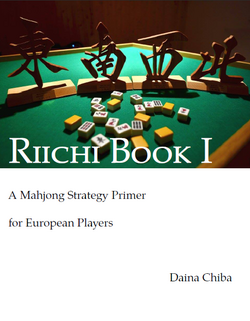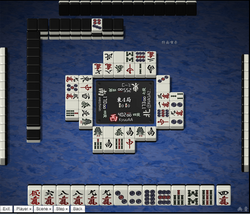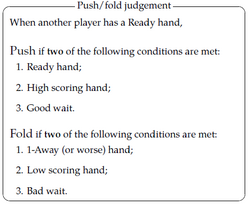Riichi Book 1

Riichi Book 1 is an English language e-book written by Daina Chiba that covers mahjong strategy. It is available for free online, and is often cited as go-to source for game improvement among the Western player base. The material is aimed to help players learn the game beyond yaku and perhaps attain tokujou level status on the Tenhou ladder.
Overview
The book is subdivided into three main sections:
- Online riichi (42 pgs.)
- Tile efficiency (89 pgs.)
- Strategy (107 pgs.)
Riichi online
This section points readers to tenhou.net, the most popular online site for riichi mahjong at the time of writing.
Tile efficiency

The second section covers tile efficiency, and concepts related to maximizing it. Having better tile efficiency means your hand is more likely to advance to tenpai.
Five-block theory
The book starts by introducing the concept of "blocks". Blocks include:
A normal hand needs four tile groups and a pair - thus, it needs five blocks. The goal of five-block theory is to identify a hand's blocks, and try to improve the weakest blocks. Prefer having five strong blocks rather than six blocks.
When four blocks are complete (e.g. three tile groups, one pair), a hand will be in tenpai, where the hand waits to complete the fifth block. Since the weakest block is likely to complete last, and a hand in tenpai waits on the last block, it's best to improve the weakest block first. Also, identifying blocks can help with identifying tenpai.
Quality of blocks
When judging blocks, the most important thing is the # of tiles that can complete it.
Sequences are easier to complete than triplets, as sequences have more tiles that can complete them. Of the incomplete tile groups, ryanmen is the strongest, as it has the most tiles that can complete it. The other types of joints can be judged on how easy it is to upgrade into ryanmen (the more ryanmen upgrades, the better).
Tile versatility
Certain tiles are more versatile than others. Tile closer to the terminals have fewer tiles that can help improve the shape:
- Tiles 3-7 each can form joints using four tile types.
- Tiles 2 and 8 can form joints using three tile types.
- Tiles 1 and 9 can form joints using only two tile types.
- Honors cannot form joints.
Therefore, when tiles are not already part of a block, prefer 3-7 tiles first, then 2/8 tiles.
Pairs
All hands require at least one pair of tiles to win. Ideally, a hand should have a pair during development. A hand can wait to complete the pair at tenpai, but this type of wait - tanki - is not ideal.
At the same time, pairs are worse than joints as they accept less tiles. Generally, a hand should aim for two pairs.
- At one pair, if the pair is turned into a triplet, you'll need to find another pair (or break the triplet). This leads to an effective acceptance of 0 tiles.
- At two pairs, either pair can be turned into a triplet safely. This leads to an acceptance of 4 tiles.
- At three pairs, any pair can be turned into a triplet, but it was already safe to turn pairs into triplets at two pairs. This leads to an acceptance of 6 tiles.
Perfect shanten
Hands have perfect N-shanten when all its joints are ryanmen or ryanmen+pair, and every tile contributes towards tenpai.
1 ryanmen+pair, 1 ryanmen
2 ryanmen+pair, 1 ryanmen
General strategies
The third section covers just under half of the book.
Scoring
It is suggested to know what score a hand can reach, even before winning in it, since knowing the values is vital for decision-making. Naturally, you'll need to be familiar with the game's complicated scoring system. This subsection breaks down the different components to knowing hand scores as well as some short cuts. Overall, it takes practice to learn the scoring table enough to actually use it in-game.
Riichi
Riichi is a major aspect of the game, but it is optional. Riichi is very powerful - in many cases, you'll want to call riichi immediately. In other cases, you may want to go damaten (no riichi). Potential factors include score situation, potential hand value, and the current hand.
Defense
Players look for tiles for defensive purposes. The book looks at genbutsu tiles, and then suji tiles.
Then kabe plays a part, where discarded tiles may form a "blockade". When all four copies of a number tile are discarded, it is impossible for an opponent to have a ryanmen wait on the number tiles towards the outside (e.g. if all four 3's have been discarded, the 1 & 2 of that suit is safe).
Open calls
Open hands can be quick, but they are inherently less valuable (cannot score certain yaku; other yaku are devalued).
The book suggests not to call if you have slow and cheap hands. Conversely, if the hand is fast or valuable, it's worth calling. However, sometimes it can be best to stay closed for the extra value.
Other tile call situations may stem on improving the wait. A drawn tile can help improve the wait of a hand, and a discarded tile can do the same. Thus, a tile call can be used to alter the shape of the hand in order to create a more favorable wait.
Sometimes, certain calls are necessary in order to complete yaku. In these cases, the tile call may serve as a means to attain tenpai at all.
The push and fold decision

One of the most difficult aspects of the game rests on the decision to either push (attack) or fold (defense). When playing offensively, the hand must either be valuable enough or fast enough. Otherwise, it's best to fold.
Players must also take into account opponent readiness. When opponents don't declare riichi, this will generally take some guesswork; it is extremely difficult to tell when said opponents are tenpai. If players are not tenpai, then defensive play is not all that necessary.
Finally, the current point standing plays into the push fold decision. Players in the lead are not as pressured to push as those who are not. Players sitting in fourth, especially in the latter end of the South round, are more inclined to push at almost any cost. The result for players not to push or dealing in may be the same, if placement is the only criteria.
South 4
South 4, or "all last", is typically the last hand of the game (barring renchan or not reaching target score). Many mahjong rule sets, particularly tournament, apply a calculation of uma, which is a point bonus applied to placement. Therefore, even a 100 point lead over an opponent can result in a big bonus.
In this last rotation, players must take note of point differences. For non-dealers, this is effectively the game's last hand. When scoring a hand, the player must take note of the point difference via both ron and tsumo. From there, the hand must be built to fit the point requirement to make up the difference for gyakuten.
South 3
South 3 effectively marks only two hands remaining in a game, barring renchan.
Etiquette
While included in the third section, this portion of the book warrants some importance, as mahjong players are suggested to learn some game etiquette. Etiquette aids in game functionality, by prompting players to not waste time. A single hanchan can take roughly anywhere between one hour to ninety minutes, depending on the average player speed.
External links
Sources
Daina Chiba cited multiple sources to produce this book, including this Wiki.